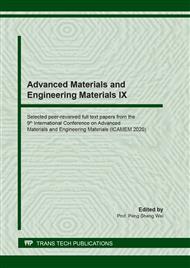p.129
p.136
p.145
p.154
p.159
p.165
p.170
p.176
p.182
Study on Preparation of Microstructured Optical Membrane
Abstract:
Micro-structured optical film is one of the micro-optical elements and has a great market demand. This article studies the microstructured optical film formed by UV imprinting: The influence of embossing pressure on microstructure replication accuracy was explored. The larger the pressure, the better the material filling. When the pressure is 5N, the microstructure replication is complete; The relationship between the radiation intensity and warpage deformation was explored, and the decrease in the intensity of the UV light source can effectively reduce the warpage deformation; The influence of the material formula on the optical properties of the product was explored. When the oligomer content was 55%, the film had a high light transmittance. At the same time, the prepared film was subjected to an apparent inspection with good microstructure replication accuracy.Microstructured optical elements are widely used in optical fields such as semiconductors, lasers, beam shaping [1-2] and solar energy [3-5] due to their unique advantages such as small size and high performance. As a key component in many industries, it has a high market demand rate. However, the microstructure forming process is complicated, the manufacturing cost is high, and the accuracy is difficult to guarantee, which has restricted its development. With the advancement of science and technology and the increase in market demand, more and more researchers and enterprises have put their eyes on the research of preparing micro-structured optical elements.At present, the commonly used microstructures are mainly icrolens array [6-8], and the processing methods include micro-imprinting [9-10], etching [11], electron beam direct writing, and micro-injection [12], etc. This article studies the UV-curing embossing process in micro-embossing. This processing method has the advantages of fast molding, high efficiency, and environmental protection. And this process is conducive to mass production and has a broad market application prospect.In this paper, the forming process and material formulation of microstructured optical film prepared by light-cured micro-imprinting were investigated, and the microstructure morphology of the preparation was analyzed apparently.
Info:
Periodical:
Pages:
159-164
Citation:
Online since:
September 2020
Authors:
Keywords:
Price:
Сopyright:
© 2020 Trans Tech Publications Ltd. All Rights Reserved
Share:
Citation:


